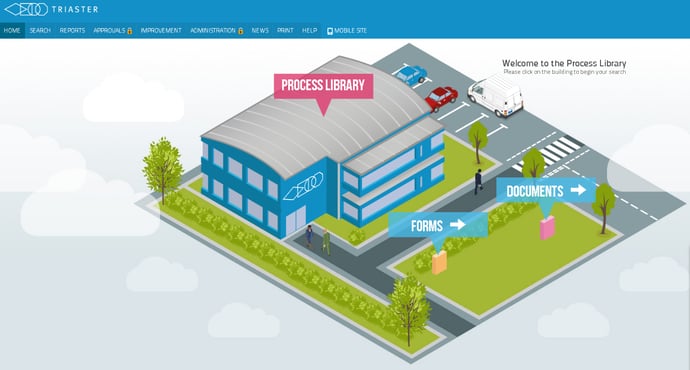Last week we explored five key reasons why your organisation should consider implementing Business Process Management and the potential benefits it delivers. In this article we are considering five more. We also explore if there are any limitations to implementing a dedicated BPM system.
1. Business Process Management helps to establish an effective quality strategy
Quality is often seen as an add-on for many businesses and quite a few of them struggle to define exactly what quality means for their organisation. In most instances there will be a quality department solely working to achieve quality certifications.
However, with the threat of risk and quality failure ever present, businesses must work to put quality at the heart of their organisations for any quality strategy to be effective.
Business Process Management provides an excellent structure for this as it will allow you to understand how your organisation currently works and will highlight areas where quality can be improved.
To learn more about how BPM can help organisations to put quality at the heart of the business, read our article: How to achieve a Quality Strategy for your Business
2. Business Process Management supports change initiatives
Getting back to business as usual is one of the biggest challenges faced by organisations following any change initiative. If changes are not managed or communicated correctly, there is likely to be a great deal of resistance from team members.
Taking a BPM approach will help to alleviate some of this resistance as it provides an excellent framework for continuous improvement, which we believe to be the most effective way to get back to business as usual.
Find out how BPM can support a change initiative by reading our article: Getting New Business Processes to Survive past your Change Initiative: The Approach for Success
3. Business Process Management helps to manage risk and prevents quality failure
As mentioned previously, risk and quality failure are a constant threat to organisations and putting a strategy in place to minimise them is often a challenge for many businesses.

Taking a BPM approach, and using a dedicated system, can help to solve these issues by providing a platform that is easily accessible to the entire organisation, and not just the quality department. This will allow you to identify responsibility and accountability for processes within your business, which will help to put quality at the heart of the business.
To learn more about how BPM can help to mitigate risk and quality failure, please read our article: Managing Risk in Business: How can I manage risk and avoid quality failure?
4. Business Processes Management increases employee engagement
Getting employees engaged with business transformations is often a struggle for many organisations, however, their involvement is key to the success of the project. If you are considering implementing a continuous improvement initiative, then BPM provides an excellent framework and support structure to help employees adjust to and engage with a new way of working.
At Triaster, we believe that investing in a dedicated Business Process Management system is the best way to ensure that business transformation projects are successful and that employees remain engaged long after any changes have been implemented.
Read our article: How can I get employees engaged enough to propose improvement opportunities to find out how BPM can support a change initiative in your organisation.
5. Business Process Management supports consistent working
Inconsistent working can often result in a lack of control, inefficiencies and an inconsistency of outcome in business. This is a real problem for organisations and one that taking a BPM approach can solve. By investing in a dedicated BPM system you can ensure that all of your business processes are made accessible to the whole organisation. However, for this to be effective, you must ensure that there is a change in culture to support this, otherwise you may risk impacting the long-term sustainability of such a project.

To learn more about this, please read our article: Inconsistent working: How can I get people to work consistently?
At Triaster, we believe the best way to really make the most of taking a BPM approach is to invest in a dedicated business process management system. But, as with any new purchase, you’ll want to weigh up the pros and cons before making an investment in time and money. This time, we’ll explore some of the limitations of BPM systems.

What are the limitations of using a dedicated Business Process Management system?
If implemented and used correctly, there aren’t many limitations to using a BPM system; however before you even begin to consider purchasing one, you need to clearly outline what you want to achieve and make sure that your chosen BPM system will support your business improvement initiatives.
However, the biggest limitations with BPM software tend to be:
- A limited understanding of your existing business processes
- Your employees not following the processes or using the system at all
- Limited or no stakeholder support for business improvement
A BPM system will only be successful in your business if:
- Senior stakeholders are involved from the very start and are in full support of the project
- Your system is used consistently and continuously by everyone in your organisation
For more information on what you need to deliver a successful BPM system to your organisation, please read the following articles:
- What problem does Business Process Management solve?
- Problems with Business Process Management: Achieving Stakeholder Buy-In
We hope that you have found this article helpful. With our many years’ experience in developing and implementing business process management systems, we understand that getting the right system for your business needs is key to the success of your improvement initiatives. Whilst we appreciate that we may not be a good fit for every organisation, but if you would like to learn more about the cost of Triaster’s BPM systems, please click here.
Related articles:
Getting New Business Processes to Survive past your Change Initiative: The Approach for Success
Managing Risk in Business: How can I manage risk and avoid quality failure?
What problem does Business Process Management solve?
Problems with Business Process Management: Achieving Stakeholder Buy-In
Written by Isobel Witts
Isobel joined Triaster in September 2014 as our Customer Success Administrator. After about a year in the role she decided marketing was where her main interest lay and she began working with Emma as a new Triaster website was developed and the Triaster blog was started. The move was very successful, resulting in her moving full time into a marketing role, firstly at Triaster and subsequently for a local marketing agency.
